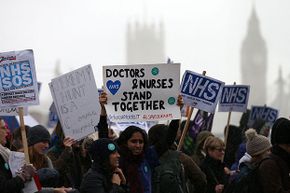The U.S. spends an extraordinary amount of money on health care. In 2013, the country shelled out more than $9,000 per person, which totaled 17.1 percent of its gross domestic product, or GDP. That's far more than the amount spent by a dozen other high-income countries — Australia, Canada, Denmark, France, Germany, Japan, the Netherlands, New Zealand, Norway, Sweden, Switzerland and the United Kingdom. How much more? France, which came in second, spent 11.6 percent of its GDP, or some 50 percent less than the U.S. [source: The Commonwealth Fund].
It wasn't always this way. Up until the 1960s and 1970s, Americans paid about the same as other developed countries for health care — 6 to 7 percent of their country's GDP. But in the 1980s, costs began skyrocketing when a cut in Medicare payments for hospital stays led to patients being discharged faster and a growth in costs for outpatient services, like nursing homes and doctors' visits. Then from 1993-2004, there was another spiral upward thanks to prescription drug prices. The growth in health care spending started to slow in 2004 and has remained slow, likely due to the 2007-2009 global financial crisis, as this moderation occurred in many countries around the world [sources: Roehrig, The Commonwealth Fund]. It might also be due in part to the implementation of the 2010 Affordable Care Act (aka Obamacare) — more on that later.
Advertisement
Even though U.S. health care cost growth has decreased, it's still higher than every other country in the world, for several reasons. In this article, we'll answer some of the most-asked questions about U.S. health care costs, starting with the most obvious one.










